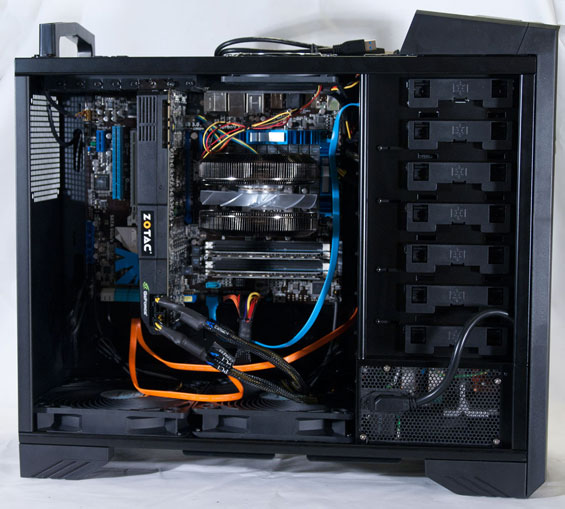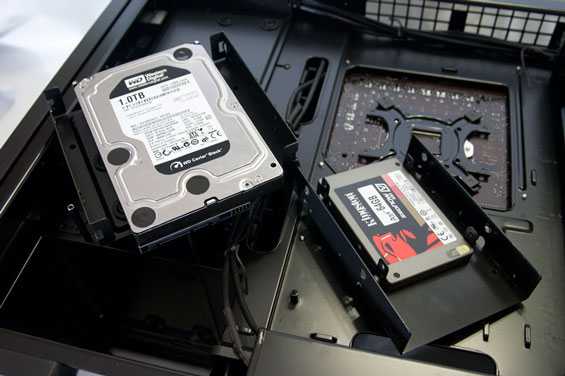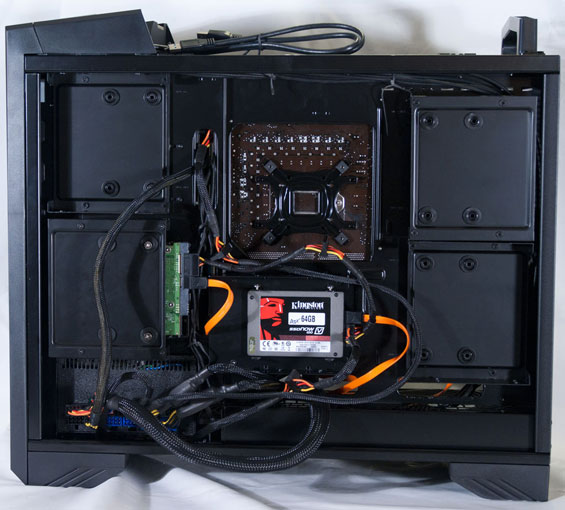SilverStone Raven RV03: Streamlined Bird of Prey
by Dustin Sklavos on July 20, 2011 1:00 AM EST- Posted in
- Cases/Cooling/PSUs
- SilverStone
- Full-Tower
Assembling the SilverStone Raven RV03
While assembly of the RV03 is remarkably straightforward given its unusual design, you may still want to keep the instruction manual handy just in case. Thankfully, the steps we usually go through when installing our testbed into a new chassis can still be followed easily enough with the RV03: motherboard, then drives, then expansion cards, then PSU, then cable everything and call it a day.

Installing the motherboard was easy enough; you'll need to place all the standoffs yourself, but the case is able to accept so many different form factors that this isn't too surprising. Our CPU cooler has pretty much stayed mounted to the board since the word "go" when we started doing these reviews, and there weren't any clearance issues. In fact this will be one of the few enclosures you'll ever see where trying to connect the AUX 12V line doesn't result in bloodletting.
Everything else is trickier--way trickier. The 5.25"-to-3.5" drive bay adapters require you to remove drive trays behind the motherboard tray in order to access the screws that keep them in place, then remove the face plates for the necessary 5.25" drive bays. Those 5.25" bay covers, by the way, are actually two pieces: a vent and an actual plate. The vents are for those that plan on using the drive bay adapters, while the plate is designed to be affixed to the front of an optical drive to maintain the looks of the face of the tower. That's a nice idea, but SilverStone only includes enough material to install just one optical drive.
Thankfully, the top 5.25" bay is empty. You'll need to pop the bay covers off with a flathead screwdriver or your fingernail and I never was able to get them to snap back on exactly right, but once you've opened up the front of the bay, the optical drive slides in easily and the tool-less mechanism works well for keeping the drive in place.

Installing 2.5" or 3.5" drives using the drive trays behind the motherboard tray isn't particularly difficult, but the optical drive was the only tool-less part of this assembly. The 3.5" drive trays each have silicon grommets that dampen vibrations, and you'll need to use special screws that come with the RV03 to mount drives in them, while the 2.5" drive tray is again--I can't stress this enough--really intended for SSDs instead of notebook-sized mechanical hard drives. (Not that most people would be interested in using notebook HDDs.) It supports two drives but it does stack them almost directly on top of each other. All of the drive trays are affixed to the back of the motherboard tray with screws, so you'll be using between six and eight screws per drive installation. This is par for the course for the unusual design, as the FT03 worked the same way.
When I mounted the GeForce GTX 580, I did note that I had to "stretch" the mounting plate on it a little more than I've normally had to in order to line it up with the screw holes. Alignment issues are honestly par for the course when assembling new cases and it's not the first time I've had to struggle a little, but this was a slightly larger gap than I've normally seen.
The power supply we use for testing cases fit into the PSU bay, but it was mighty snug and at times I was worried I was going to scratch up or damage something. You can force it almost all the way in, then use the mounting screws to get it the rest of the way (minds out of the gutter, folks) and lock it into place. I've read other reviews where reviewers have had issues with connecting the power cable to the PSU due to a cable tie on the interior of the case, but my review unit had no such tie and it's my understanding that was an issue confined to early review hardware. The case I have could easily connect the PSU cable anywhere within the confines of the bay.
Routing cables was for the most part simple but the space behind the power supply, despite the allowance made in the design of the case panel, was still pretty tight. This has been yet another enclosure where I've been overwhelmingly glad the power supply was modular. There's definitely space behind the motherboard tray for all of the cables along with places to wrap zip ties, but part of the issue is that ventilation behind the motherboard tray is actually important in the RV03. If you're planning to install a rear 120mm fan (and it's something I'd seriously consider), this could become a bit fraught. Finally, the USB 3.0 ports at the top of the case still use routing cables to the I/O cluster instead of a front panel header. It would've been nice to have had a bridge on hand at least, but some motherboards come with a USB 3.0 port bracket that could probably just be routed internally behind the motherboard tray.

"Closing up" took about the same amount of effort it almost always does with traditional enclosures, requiring some pressure on the back panel to lock it into place. The RV03 does require an additional step beyond most cases, though: since the I/O cluster and expansion slots are at the top of the case instead of the rear, there's a vented cover that needs to be snapped on and off. I've read some people concerned that the cover is fragile, but I removed and reattached it quite a few times and it seems fine. Cables get routed out a special loop in the back of the case and there's enough space there for even the menagerie coming out the back of my own case. Note that if you're using any type of display connector changer, like DVI-to-VGA, there isn't enough clearance for the large block adapters; you'll need a flexible one.
















25 Comments
View All Comments
V3ctorPT - Wednesday, July 20, 2011 - link
Sorry man... I have an FT02WRi and it's a beautiful case, it's not like this ugly case.http://img.zwame.pt/portal/caixas/silverstone/FT02...
It's not even close to this RV03
Zoeff - Wednesday, July 20, 2011 - link
The FT02 was actually my first choice but that actually costs about 90 euros more than the RV03. So I went for the RV02-E which only costs 10 euros more than the RV03.HanSolo71 - Wednesday, July 20, 2011 - link
Dustin first off I have been loving your recent work keep up the great work.Secondly as a reviewer myself I have to agree about the type of noise these cases give off. I have found that it isn't so much of a winny noise that other cases have but rather a low wooshing noise that sounds much like the noise that the ventilation system in a building would give off. Also I would have to agree that while the RV02 was far from subtle the RV03 went in the wrong direction. Personal I love the Apple-esque design of the TF02 and was hoping more of its design would rub off on the new RV03 design.
Still with all of its faults I love the RV02 as it is great to work with and keeps my 4.7Ghz i5 2500k nice and cool.
7amood - Wednesday, July 20, 2011 - link
I wanted a trusted review for the RV03 and I finally got it from a trusted site.I'm missing a review for the RV02-E.
You might wanna review the SG08 when it comes out, it's a nice one.
Thanks
beginner99 - Wednesday, July 20, 2011 - link
..the fractal define R3 case. It has tons of 3.5 bays (and only 2 5.25), more than enough possibilities for mounting fans and a simple, straight forward design. ( I have the R2)It is also small compared to monsters like the Ravens or FT. Only complaint i have is space behind mobo tray and the side panel mounting but maybe that was improved in the R3.
AssBall - Wednesday, July 20, 2011 - link
Great review, Dustin.The killer for me on this case is having the I/O come out of the top. It is a cool idea, but I put too much junk on the top of my cases; I need em to be flat for the extra shelf room. Their nontraditional approach to cooling makes me a little weary too. The thing looks pretty nice though.
Footman36 - Wednesday, July 20, 2011 - link
I just got rid of this case. I gave it to my father in law. It now houses a very simple i920 at stock with stock cooler and 5670 with Artic Cooling HSF.I previously owned the RV-02 which was an Epic Fail, burnt out an X58 motherboard around the IO area as there was not enough air flow to cool the VRM's positioned there.
Anyhow, decided to try the RV-03. (I also own the Thermaltake Level 10 GT and the CM HAF-X).
Not a good idea, first of all the design is terrible, from the lousy magnetic dust filters that either vibrate or fall off if you blow on them, to the abysmal design of the hard drive cages!!!
The icing on the cake is this type of design does not work with certain heat pipe coolers. For example my pair of GTX 560 Ti's would run full load at 68C in the HAF-X, but in the RV-03 they hit 94C before shutting down the computer (and this was after 10 minutes of BF2).... This is by far one of the loudest cases I have owned at full speed.....
Avoid like a plague....
While i like the idea of this design it is not as efficient as standard cases with the motherboard in the usual position....
Dustin Sklavos - Wednesday, July 20, 2011 - link
I'm not sure your complaints are entirely fair.First, just looking at the airflow in the RV03 vs. the more traditional cases I have on hand, I don't really see how the inverted motherboard layout and airflow design starves the VRMs any more than a traditional layout would.
Second, SilverStone even says as much that these enclosures aren't going to be at their best with heatpipe based GPU coolers that don't exhaust out the back of the case; SilverStone's design is really geared towards the blower-style coolers that higher end graphics cards tend to ship with stock, and from our testing it does handle those with aplomb.
It's true the RV03 is pretty loud at full speed, but it also doesn't NEED to be run at full speed.
The rotated board kind of changes the game a bit. In some situations it's not going to seem quite as efficient as a traditional orientation, but once we went into the overclocked configuration I think it proved itself.
Footman36 - Thursday, July 21, 2011 - link
Reviewing a case is not the same as living with a case 24/7. I have many months of experience with the RV-02 and RV-03 Dustin. I agree with your review on many levels but feel that there are inherent issues with this case, notwithstanding the 90 degree turnaround of the motherboard.First of all the two front mounted drive cages are the worst designed drive cages I have ever had the misfortune of working with. They need to be completely disassembled before a drive can be placed within. This takes a considerable amount of time and if you want to add an extra HHD or SSD after the fact you have to disassemble again.
The bottom dust filters do not stay in place and vibrate if they are even 1mm out of place, what a terrible idea compared to the dust filter design of the RV-02.
Finally airflow, while Silverstone may indicate in their manual that the RV03 may not be suitable for certain heat pipe coolers or GPU's I wonder how many purchasers will have access to this information BEFORE they buy the case? Hot air rises, as we all know and in an atx case the IO plate is not the top of the computer, there is usually space above for a power supply or top mounted fan, so hot air does not accumulate around this point. In the RV-02 and RV-03, the IO plate is the uppermost point in this case and as it is solid, the hot air remains around this area in a pocket, heating up the VRM's which again dump more heat in to this localized area. I guarantee you that after running for 3-6 hours you will find the IO plate extremely hot and this is ultimately what caused a VRM to burn out on my X58 motherboard according to the report from their support team.
I am a enthusiast and this year alone I have purchased approximately 15 or so cases for my builds including Silverstone, Coolermaster, Antec, Lian-Li and NZXT....
In any event, this case is performing well for my father in law who likes the top IO ports as he does not have to pull the PC out of position when he wants to connect a peripheral, also I used the solid i920 stock HSF and the 5670 has solid HSF, the hard drive was mounted on the backside of the case and the fans are running at low. I just believe that there are better cases available for less, the CM 690 springs to mind for one.....
Looking forward to your next review.
MagicPants - Wednesday, July 20, 2011 - link
One thing I'd really like to see in case reviews is just how much you can jam into the thing. Most of the stats relayed in the article are things I can pick up from reading documentation, or opinions on the looks and build quality.What I really want to know is how many video cards can I jam in into the thing, will the cooling still work well, and will there be enough room left over for a sound card.
I'd like to see an sli/crossfire system with a soundcard, and a pci-xpress interface ssd. Single video card only installations in case reviews are next to useless. Please review how well each case will work in (and limit) the type of system it is meant for.
Most case reviews (on this and every other mainstream site) are the equivalent of testing the newest video card with only WoW, or testing a race car by driving to the store.